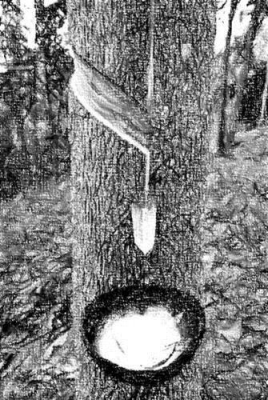The act of giving birth in farm animals is called
Brooding
Cloning
Parturition
Gestation
Correct answer is C
Parturtion is the process of giving birth in animals.
The national tree-planting campaign is aimed at stimulating
Wildlife conservation
Afforestation
Taungya farming
Forest reservation
Correct answer is B
Afforestation is planting of trees where they have not been planted before.
What is the main use of a gunter's chain?
Taking measurement of distance
Determining the depth of soil moisture
Calculating the slope of the land
Restraining bulls
Correct answer is A
Gunter's chain is a distance measuring device used for surveying.

Study the diagram above and answer question
The farm tool associated with the diagram above is
Knife
Secateurs
Shears
Cutlass
Correct answer is A
The tree in this question is a rubber tree and the process depicted is rubber tapping. Rubber tapping is the process by which latex is collected from a rubber tree. The latex is harvested by slicing a groove into the bark of the tree at a depth of one-quarter inch with a hooked knife and peeling back the bark

Study the diagram above and answer question
The crop associated with the diagram above is?
Theobroma cacao
Zingiber officinale
Hevea brasiliensis
Gossypium hirsutum
Correct answer is C
Hevea brasiliensis, the Pará rubber tree, sharinga tree, seringueira, or, most commonly, the rubber tree or rubber plant, is a flowering plant belonging to the spurge family Euphorbiaceae. It is the most economically important member of the genus Hevea because the milky latex extracted from the tree is the primary source of natural rubber.
JAMB Subjects
Aptitude Tests